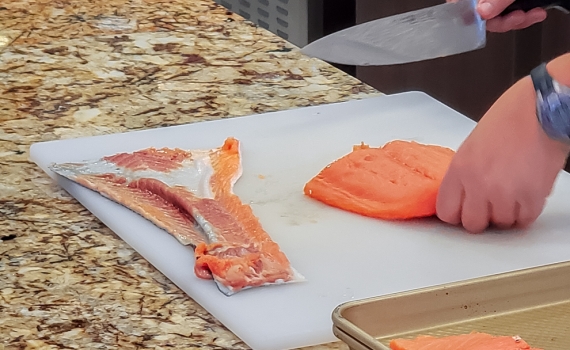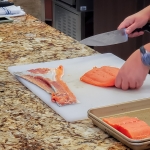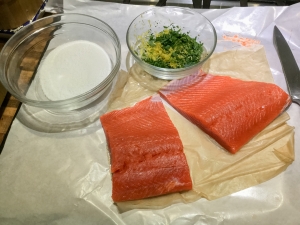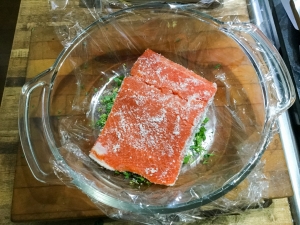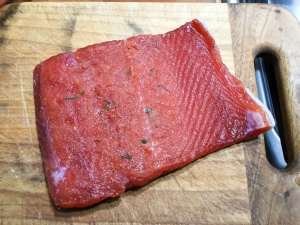Gravlax
Category:Food Tags : dry brine gravlax salmonMaking Gravlax
Gravlax is actually pretty easy to make. The basic recipe includes applying a dry brine with herbal elements to some fish protein. In this case, salmon, but it could just as well be another firm, meaty fish such as haddock or halibut. Most brines are made of some combination of salt and sugar rubbed on the flesh, put in a sealable bag or wrapped tightly in cling wrap and refrigerated for at least 24 hours. The recipe below is a spin off Oceania's Culinary Center 'If it Swims' on-board course.
Cured Salmon Gravlax
A simple take on an Eastern European classic. Enjoy for holidays or anytime.
Course Appetizer, Breakfast, Brunch, Gravlax, Hors d’Oeuvres
Cuisine Eastern European, Scandavian
Keyword brine, curing, gravlax, Keto, salmon
Prep Time 20 minutes minutes
Curing Time 1 day day
Servings 1 Pound
Author Kevin
Ingredients
The Protein
- 1 lbs boneless, skinless, salmon fillet
The Cure
- 1/2 cup kosher salt
- 1/2 cup monk fruit sweetener Same amount of sugar, but won't be keto
- 1 tbsp pink peppercorns
- 4 juniper berries
- 4 allspice berries
- 1 bunch fresh dill
- 3 tbsp Ouzo Aquavit is a good substitute, or vodka
Instructions
Dealing with the Salmon
- From your fishmonger, if you're lucky enough to live by a lake or ocean, get the center portion of the fish. Salmon from this section is typically 1" thick or more. If you're adventuresome, or have skills, you can de-skin the fish yourself. If you're new to this, have the grocer do it for you.
- Run your hand over the length of the fillet feeling for bones. There is usually a line of thin bones near the thickest part running down the length of the fish. Pull out the bones with a pair of long, needle-nosed pliers. You can just pick up a pair at the hardware store, making sure they stay for kitchen use only! Be careful not to damage the flesh too much. Practice makes perfect.
- Pat the fillet dry and place on a double layer of cling wrap, enough to completely wrap up the fish like you would a present.
Mixing the cure
- This is the easiest part. Just thoroughly combine the salt and 'sugar' in a small bowl.
- Place the double layer of cling wrap - about three times the size of the fillet - on a flat surface. Again, think of wrapping a present. Place half the salt & sweetener on the center of the wrap. Spread it out to the size of the fillet. Pour about half the remaining cure ingredients on top of the salt and sweetener. Place the fillet on the cure. Cover the top of the fillet with the remaining salt and sweetener, followed by scattering the rest of the cure on top. Wrap the fillet, but not too tightly. You want some of the water to get out of the wrapping during the cure.
- Place the wrapped fillet on a baking sheet and place in the refrigerator for 24 to 26 hours, turning over every 12 hours.
- When the gravlax is ready, remove from the wrap and gently wash off the cure in cool water. Be gentle. Pat dry with paper towels and place on a cutting board of your choice. Thinly slice at a steep angle and you're ready to serve.
Serving up the Gravlax
- Presentation depends on your style and occasion. I like a simple presentation. A few lemon wedges and capers, perhaps some sour cream on the side. Toast rounds or unseasoned crackers are also good to have near.

